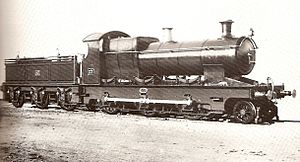GWR 2600 Class
| GWR 2600 'Aberdare' Class | |||||||||||||||||||||||||||
|---|---|---|---|---|---|---|---|---|---|---|---|---|---|---|---|---|---|---|---|---|---|---|---|---|---|---|---|
 | |||||||||||||||||||||||||||
| |||||||||||||||||||||||||||
| |||||||||||||||||||||||||||
| |||||||||||||||||||||||||||
| |||||||||||||||||||||||||||
The Great Western Railway (GWR) 2600 Class or Aberdare Class was a class of 2-6-0 steam locomotive built between 1900 and 1907. They were a freight version of the 3300 and 4100 classes, both 4-4-0 locomotives. Therefore, the design was adapted and became a 2-6-0 type; the resulting locomotives were used for hauling coal trains between Aberdare and Swindon.
Numbering
The class began in 1900 with a prototype, No. 33, renumbered 2600 in 1912. The rest were numbered 2601–2680 and were built between 1901 and 1907.
| Year | Quantity | Lots No. | Serial Nos. | Locomotive Nos. | Notes |
|---|---|---|---|---|---|
| 1900 | 1 | 128 | 1886 | 33 | renumbered 2600 in 1912 |
| 1901 | 20 | 131 | 1908–1927 | 2621–2640 | |
| 1901–02 | 20 | 133 | 1929–1948 | 2641–2680 | |
| 1902 | 20 | 135 | 1949–1968 | 2661–2680 | |
| 1903 | 10 | 123 | 1796–1805 | 2611–2620 | Lot and serial numbers out of sequence |
| 1906 | 1 | 156 | 2125 | 2601 | |
| 1906 | 9 | 166 | — | 2602–2610 | Renewal of 2602 Kruger class locomotives |
British Railways
British Railways (BR) inherited nos. 2612/20/3/43/51/5/6/62/5/7/9/80 in 1948.[2] By 31 August 1948, only four were left: nos. 2620, 2651, 2655, 2667.[3]
Withdrawal

They were withdrawn from 1934 onwards. Five Aberdares (2640, 2648, 2649, 2652 & 2657) withdrawn in early 1939 were not cut up but stored as Second World War reserves. These five reentered service by January 1940. Their withdrawal began again in 1944 until the last member, number 2667, was withdrawn in October 1949. No examples were preserved.
References
- ^ Allcock et al. (1968), pp. 23, 29–30.
- ^ le Fleming (1954), p. G43.
- ^ British Railways Locomotives 1948, Part 1. London: Ian Allan. 1948. pp. 11, 17.
- Allcock, N. J.; Davies, F. K.; le Fleming, H. M.; Maskelyne, J. N.; Reed, P. J. T.; Tabor, F. J. (1968) [1951]. White, D. E. (ed.). The Locomotives of the Great Western Railway, part one: Preliminary Survey. Kenilworth: RCTS.
- le Fleming, H.M. (October 1954). White, D.E. (ed.). The Locomotives of the Great Western Railway, part seven: Dean's Larger Tender Engines. Kenilworth: RCTS. ISBN 0-901115-18-5. OCLC 655235293.
External links
- Use dmy dates from January 2018
- Use British English from January 2018
- Commons category link is on Wikidata
- Great Western Railway locomotives
- 2-6-0 locomotives
- Railway locomotives introduced in 1900
- Standard gauge steam locomotives of Great Britain
- Scrapped locomotives
- Freight locomotives
- All stub articles
- United Kingdom steam locomotive stubs